With nearly 500 available Liveaboards, it can be overwhelming trying to figure out which one to choose. We’ve rounded up a list of the best scuba diving Liveaboards around the world, from popular dive destinations to some you may have never heard of. Plus we’ve included expert tips for booking the best Liveaboard for you!
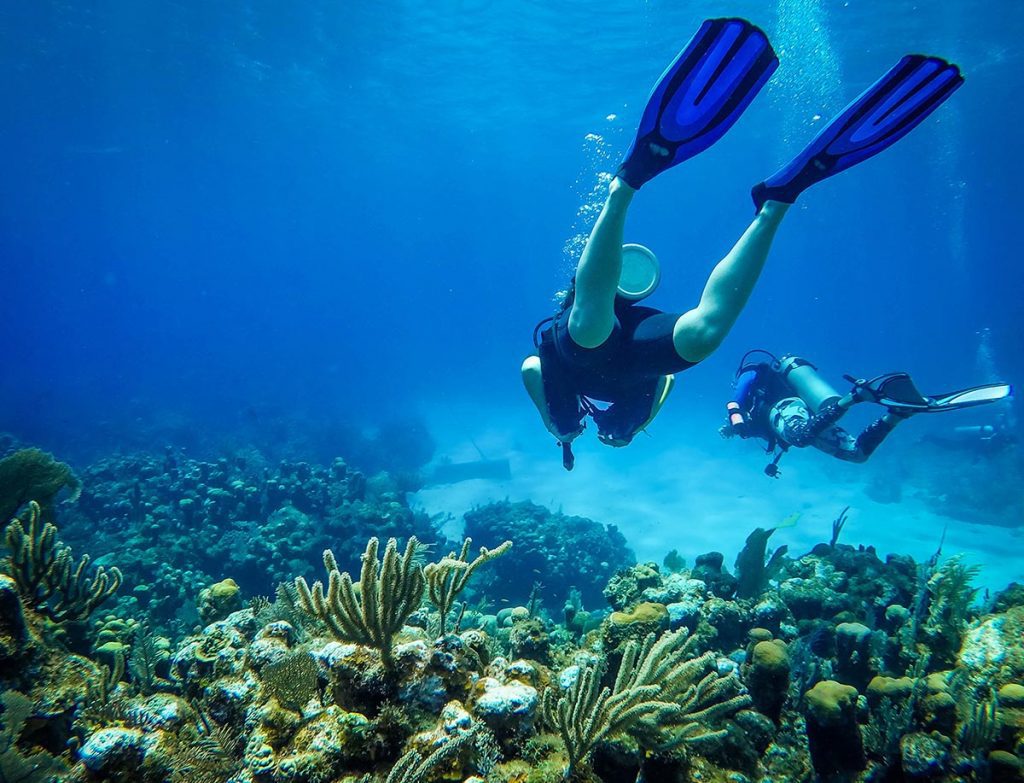
If you’re like us, scuba diving is one of those hobbies that you just can’t get enough of.
There’s just something about exploring the underwater world that is addicting. Maybe it’s the peacefulness of floating above colorful coral reefs teeming with sea life, or maybe it’s the thrill of encountering macro species.
Whatever it is that gets you hooked, we all tend to continue this hobby for similar reasons: There is no experience even remotely similar on land.
We first got our open water certification on the Thai island of Koh Tao, and we decided to stay and get our advanced certification because we loved it so much.
Since then, we’ve been diving all over the world, including two scuba diving Liveaboards, and to say they were incredible would be an understatement! We learned so much and got really comfortable being underwater with so much practice and excellent dive guides.
With Liveaboard, you can experience scuba diving in an entirely unique way. Reach remote areas and dive in places where marine life is plentiful and diverse, away from the disruption of regular tourism.
One thing that we really love about diving is that it can be a lifelong hobby. Some of the people we’ve met on our dives have been doing it for decades, which is pretty inspiring and definitely #lifegoals!
In this article, we will walk you through the basics of participating in a Liveaboard dive trip and suggest some of the best scuba diving Liveaboards around the world.
Scuba Diving Liveaboards Guide
- What is a Liveaboard?
- Our experience with Liveaboards
- Top diving destinations + Liveaboard recommendations
- Tips for choosing a scuba diving Liveaboard
- What to pack for a Liveaboard diving trip
What is a Liveaboard?
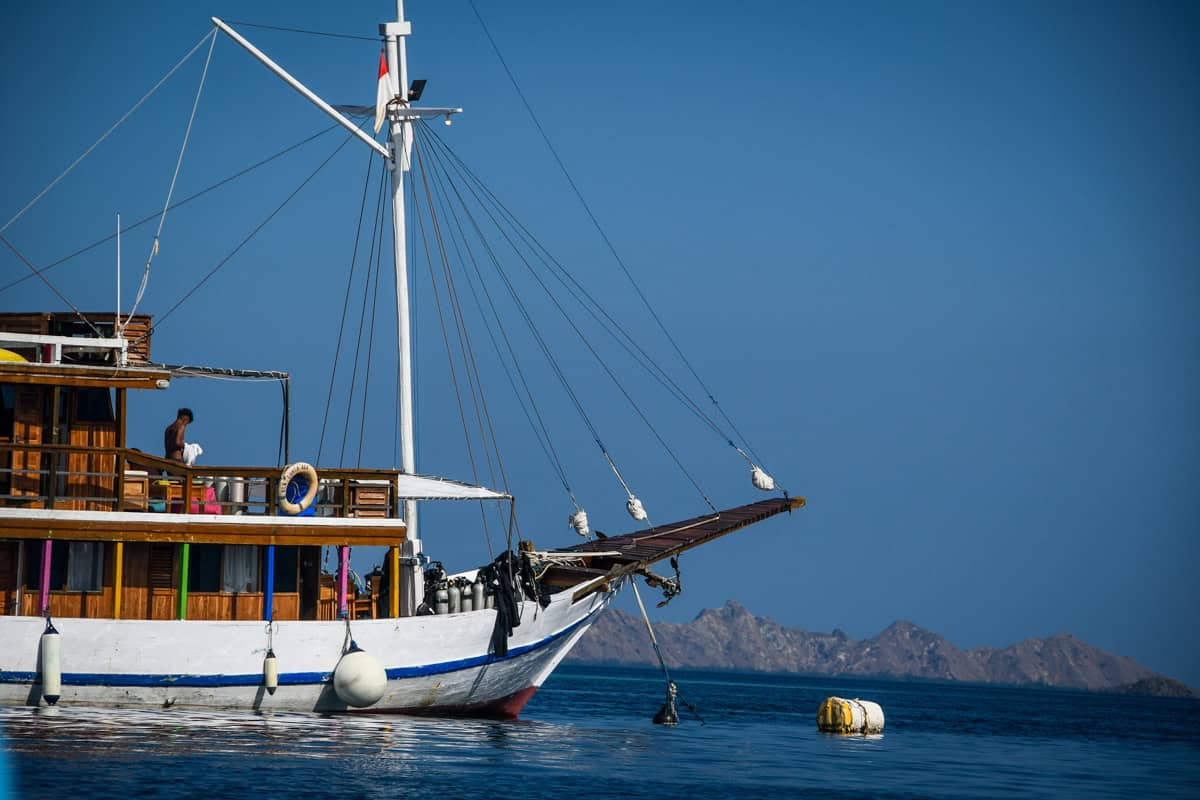
In the simplest definition, a Liveaboard is a multi-day boat trip that is often times focused on scuba diving*.
Most Liveaboard diving trips take a small group of guests (around 16, depending on the boat) and have fully catered facilities. Guests get the option to choose their own room or stay in a shared bunk room, and actually sleep, eat and relax on board the ship when they are not diving.
Trips are anywhere from 3 days to full 14-day excursions in some of the world’s top diving destinations where you will eat, sleep, and dive, day after day.
Want more information? Here is everything you need to know about Liveaboard diving trips.
*There are non-diving Liveaboards too, but for the purpose of this article, we’ll be focusing on only diving Liveaboards.
Our experience with scuba diving Liveaboards
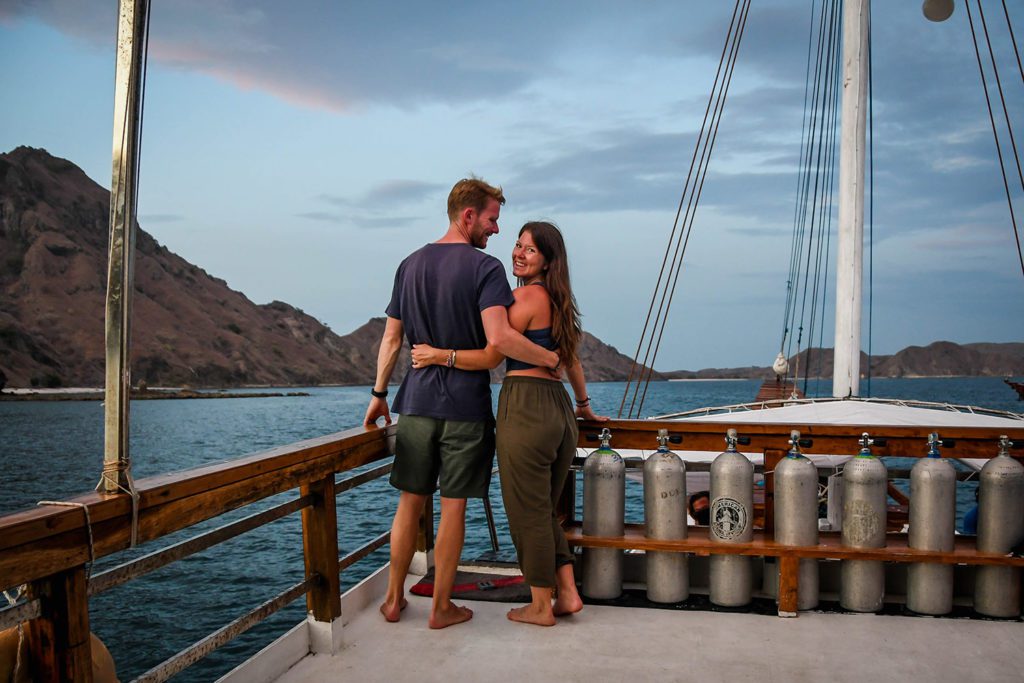
We’ve been fortunate enough to have experienced scuba diving Liveaboards in two iconic diving destinations around the world.
We did our first Liveaboard in Similan Islands, Thailand on a short 3-day excursion through the national marine park. We had such a wonderful experience that our fins… err, feet… were itching to do another.
So we booked a second voyage, this time on a 5-day voyage in Indonesia on a Komodo Liveaboard. And let me tell you, this certainly won’t be our last Liveaboard!
Don’t just take our word for it… See for yourself with this video from our most recent Komodo Liveaboard experience.
Top diving destinations + best Liveaboards in each place
These are our top picks for scuba diving Liveaboards in the top destinations for diving around the world!
Raja Ampat, Indonesia
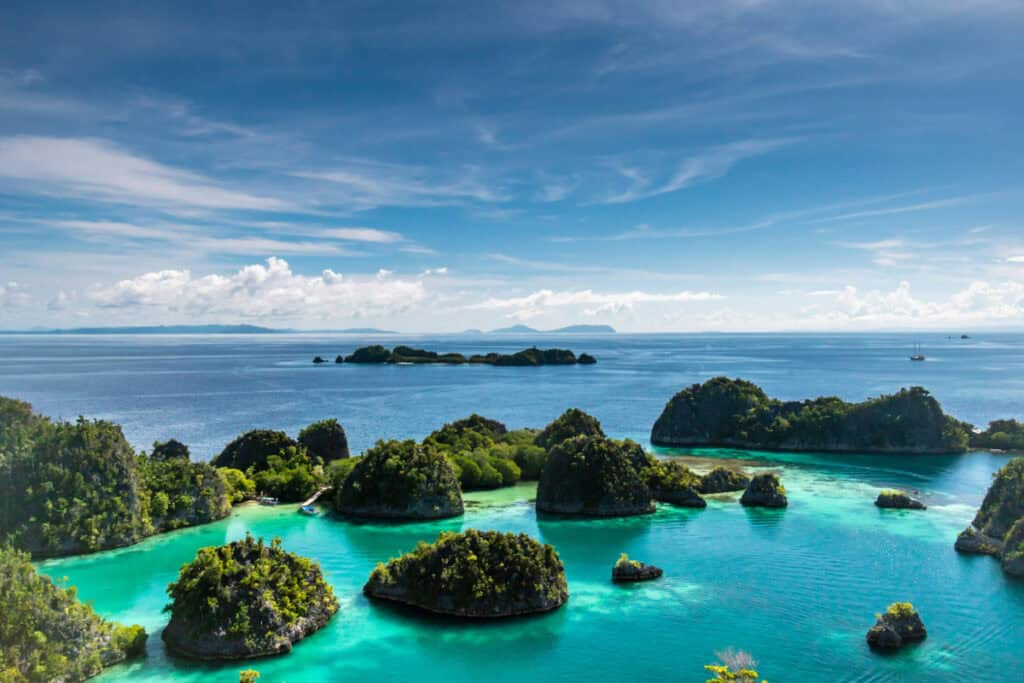
- Best time of year for diving: Raja Ampat is a year-round diving destination. However, you will have the calmest and clearest waters from December – March. This is also the best time to spot manta ray in the area.
- Average water temperature: Water temps stay consistent year round at about 82-86 °F, or 28-30 °C.
Located in the West Papua Province of Indonesia, Raja Ampat is an archipelago made up of hundreds of tiny islands and pinnacles, most of which are uninhabited. Underneath the surface of the pristine turquoise waters, the coral reefs are rich with marine life with everything from the tiny pygmy seahorse to manta rays.
Known to have the highest number of corals, fishes, and mollusks, Raja Ampat represents the richest marine diversity in the world. Because so many islands in Raja Ampat are undeveloped, the only way to access some of the best diving there is by Liveaboard.
Our top Liveaboard choice: Amaya Explorer
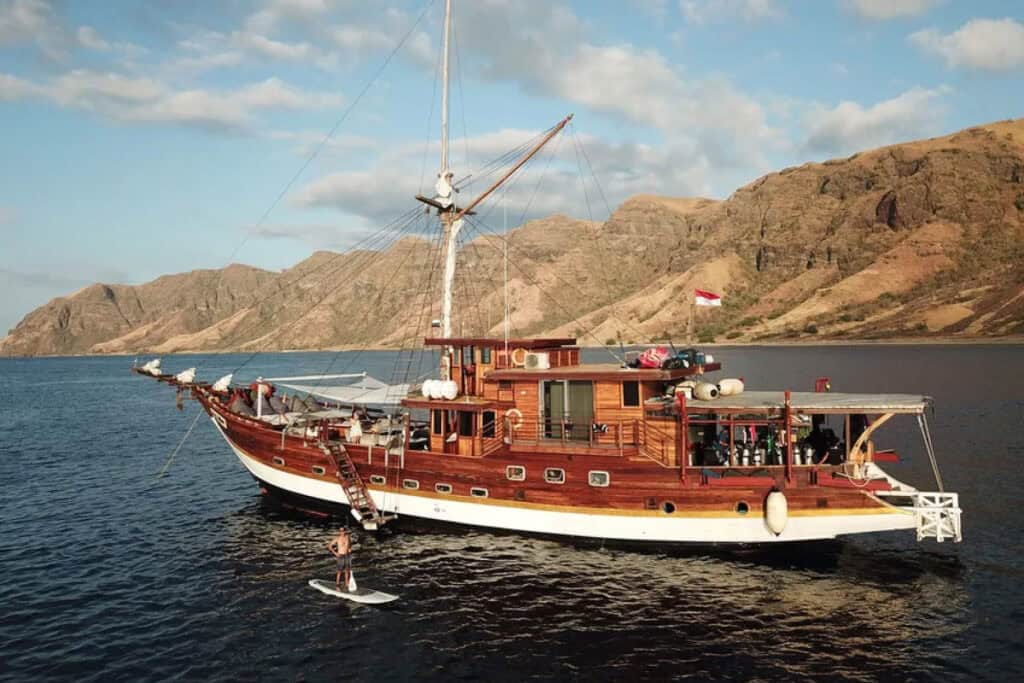
- Length of voyage: 7, 8 and 11 days
- Ship size: 16-20 guests
- Cost: starting at $296 USD / day
The Amaya Explorer vessel combines traditional wooden phinisi design with modern amenities, providing everything needed for a top-tier dive trip in Komodo.
Each cabin is fully air-conditioned and tastefully decorated, featuring comfortable beds, ample storage space, charging ports, and private en-suite bathrooms.
Social areas include a bright and inviting indoor lounge, bar, and dining area. The outdoor dining deck is perfect for enjoying gourmet Indonesian cuisine or relaxing under the stars after a day of diving.
We also have an entire article where we rounded up the best Liveaboards in Raja Ampat for every budget.
Galapagos Islands, Ecuador
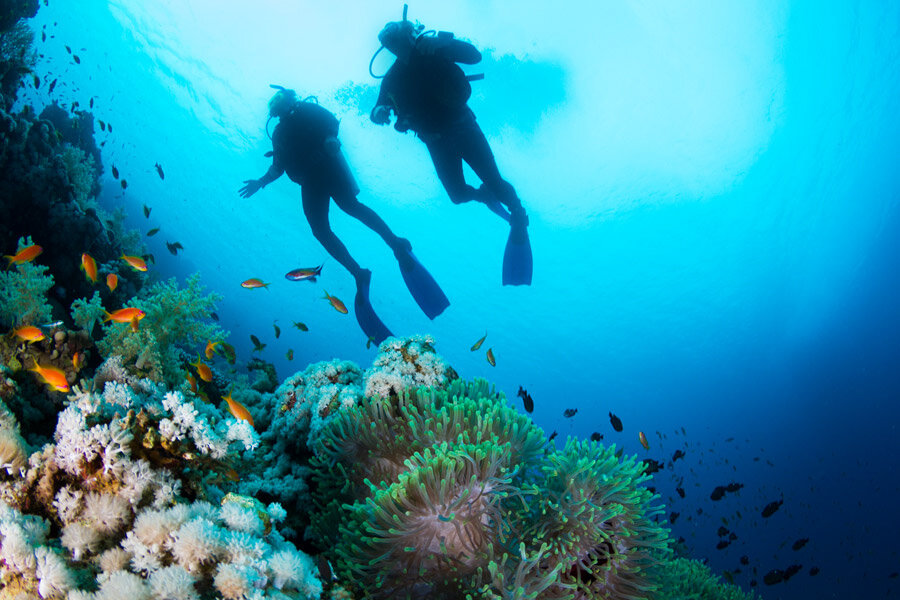
- Best time of year for diving: Diving is possible in the Galapagos all year round. January – June is the best time to spot manta rays and hammerhead sharks; July – December for whale sharks.
- Average water temperature:
- January – June: 75-82 °F, or 24-28 °C
- July – December: 62-68 °F, or 17-20 °C
Home to a myriad of marine life found nowhere else on this planet and excellent visibility, it’s no wonder the Galapagos is one of the best scuba diving Liveaboard destinations in the world.
Some of the highlights you will hope to see while diving here include schooling sharks, mantas, the unique marine iguana, giant mola-mola, sea lions, and penguins among beautiful coral reefs.
Our top Liveaboard choice: Tiburon Explorer
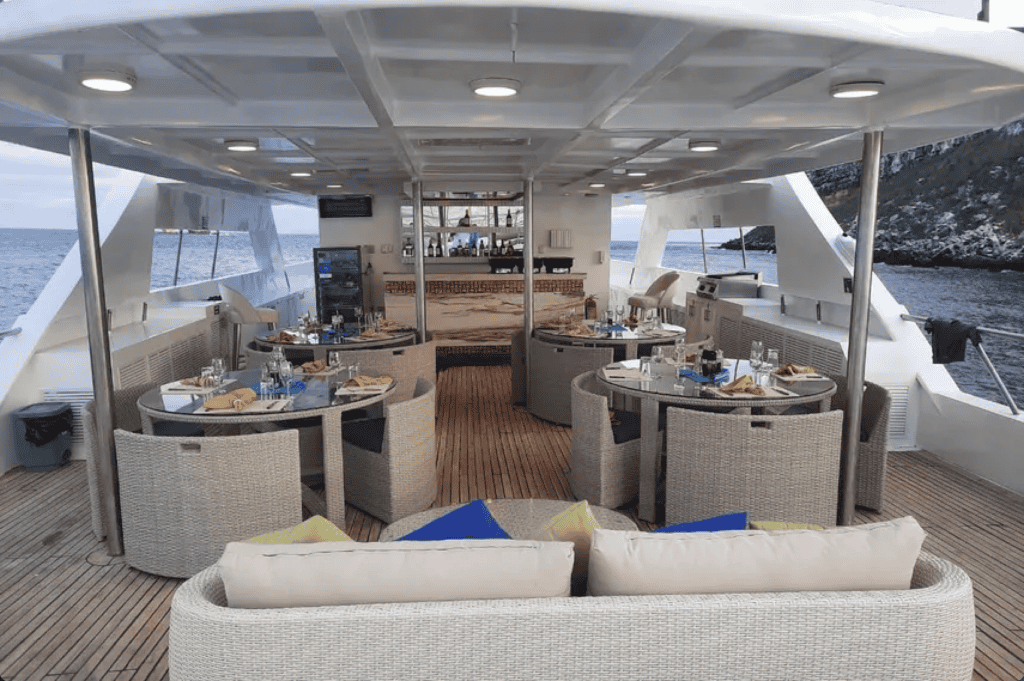
- Length of voyage: 8 days
- Ship size: 16 guests
- Cost: starting at $714 USD / day
The Tiburon Explorer Liveaboard offers an exceptional Galapagos scuba diving experience. The ship was built by divers, for divers, the expansive dive deck is equipped with individual gear bins, air and nitrox filling stations, and freshwater rinse tanks for dive equipment and cameras.
The ship can accommodate up to 16 guests, featuring 9 comfortable staterooms on the lower and main decks. Each air-conditioned cabin is equipped with a private en-suite bathroom, and offers queen or twin beds along with ample storage space.
Social areas on the Tiburon Explorer include a modern main-deck salon with a TV and lounge area, and a dining room where delicious chef-prepared cuisine is served. For relaxation and socializing, guests can enjoy the top deck, the partially covered sun deck, or unwind in the hot tub.
Be sure to check out our round up of the best Galapagos Liveaboards for every budget.
Red Sea, Egypt
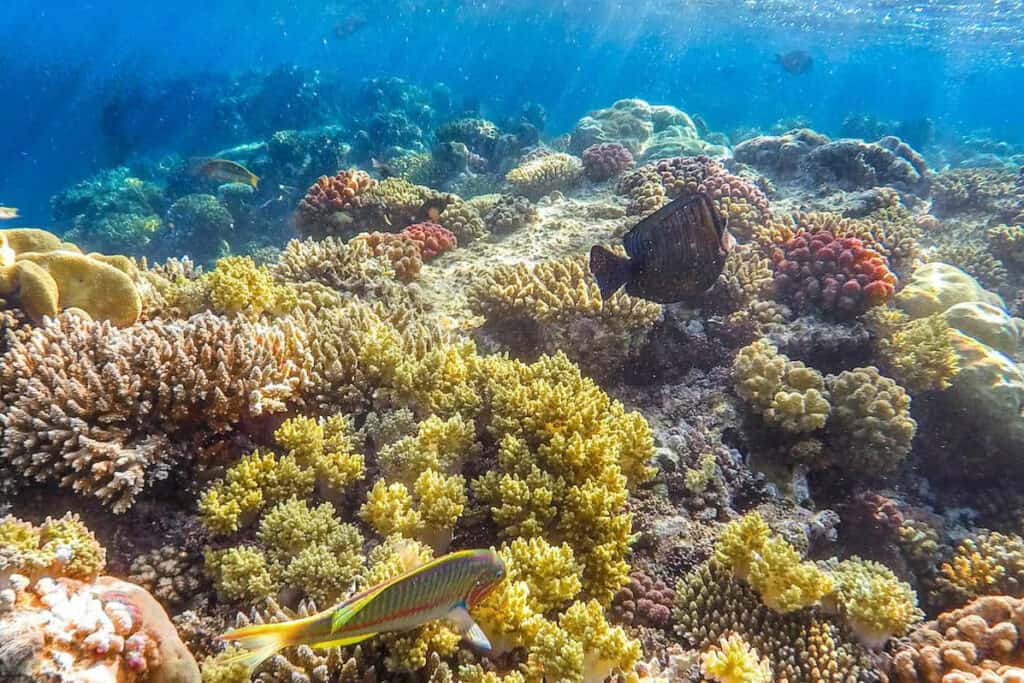
- Best time of year for diving: Diving in the Red Sea is good all year round. However, May – July are the warmer summer months and a good time to see whale sharks, hammerhead and manta rays.
- Average water temperature: Water temperatures rarely fall below 71 °F / 22 °C during the winter months, and usually reach 86 °F / 30 °C during the summertime.
Our favorite diving instructor said that the best dive sites he’s ever experienced are in Egypt, so you’d better believe this is on our bucket list!
Known for having incredibly calm and clear conditions, the light-filled reef systems in Egypt’s Red Sea are the perfect place for new divers, underwater photographers and anyone who wants to get a good look at life under the sea.
The diversity of marine life and dive sites – from plentiful wreck dives to teeming coral reefs – makes this one of the top diving destinations in the world.
Our top Liveaboard choice: Ghazala Explorer
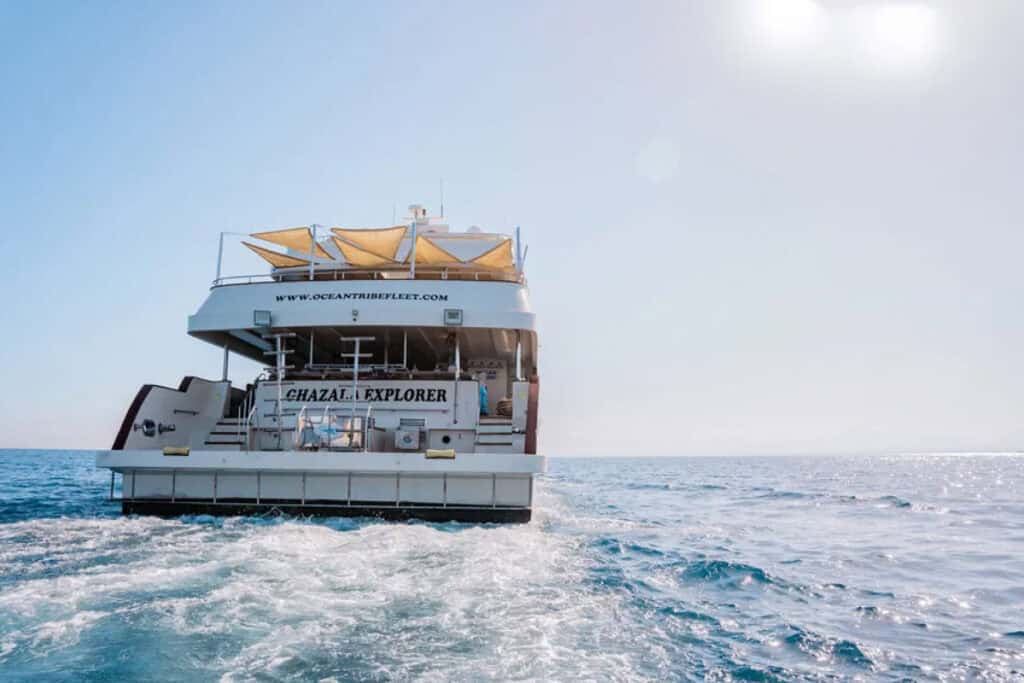
- Length of voyage: 8 days
- Ship size: 24 guests
- Cost: starting at $148 USD / day
A sleek, modern 37-meter (121-foot) motor yacht, the Ghazala Explorer offers a range of itineraries throughout the Red Sea. It accommodates up to 24 guests in 12 air-conditioned, ensuite cabins, including 9 twin bed cabins and 3 double bed cabins.
Guests can enjoy meals or relax with a drink in the spacious indoor dining and lounge area. The sun deck offers seating areas and bean bags in both covered and open spaces. The large dive deck at the rear provides ample storage for dive equipment and plenty of space to prepare for dives, while the rear platform ensures easy access to and from the tenders.
Similan Islands, Thailand
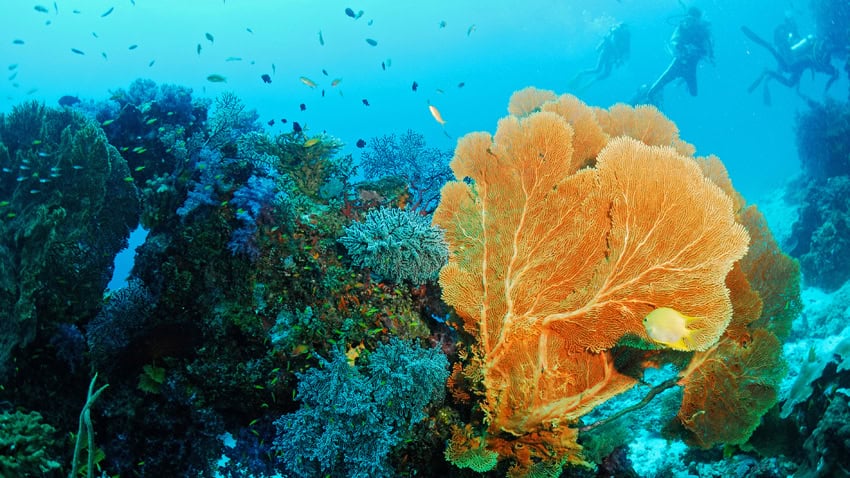
- Best time of year for diving: The national park is only open from November – mid-May due to unique weather patterns, and diving is limited to these months. Your chances of spotting whale sharks and manta rays are increased from February – April.
- Average water temperature: Stays constant throughout the diving season at 84° F / 29° C.
The Similan Islands make up a national marine park off the Andaman Coast of Thailand. Often regarded as the best place to scuba dive in Thailand, the marine life and calm, tepid waters make this a great place for beginner divers as well as those who are more advanced.
We did our first Liveaboard diving trip in the Similan Islands and it was an incredible experience that had us itching to book another.
There are plenty of small, colorful corals and fish to see, but most divers in the Similan Islands cross their fingers that they’ll have the good fortune to spot an elusive whale shark. We didn’t get so lucky, but maybe you will! (We’re sending you our good luck karma now!)
Our top Liveaboard choice: The Junk
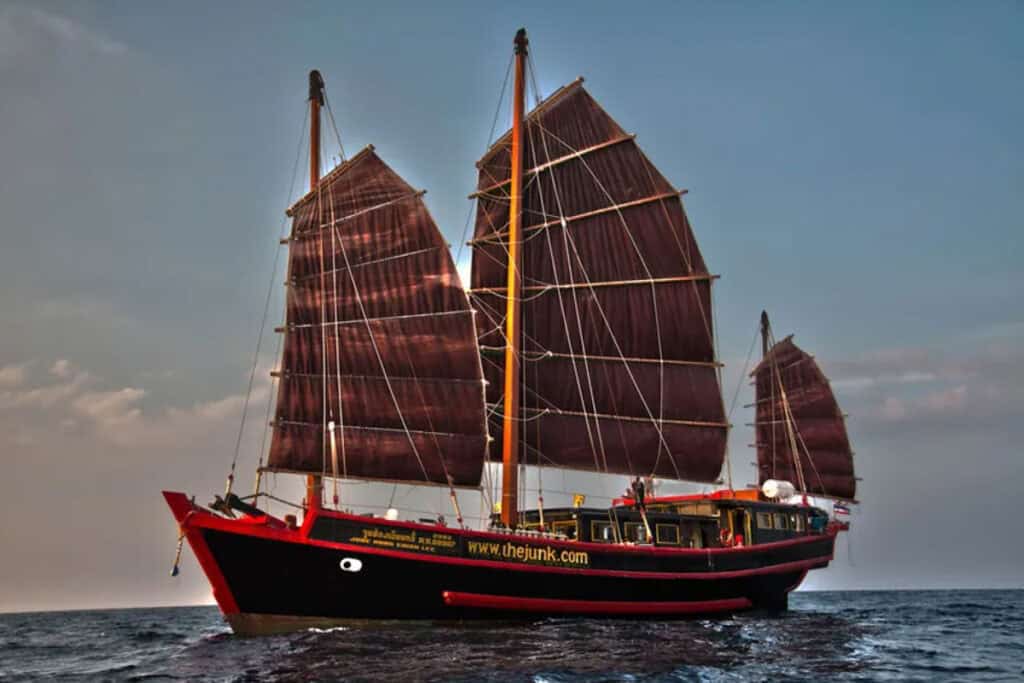
- Length of voyage: 3, 5 and 7 days
- Ship size: 6 guest cabins
- Cost: starting at $159 USD / day
Once part of a small merchant trade fleet, The Junk underwent a complete renovation to turn this authentic sailing vessel into a diving Liveaboard adventure.
The ship now features 6 air-conditioned cabins with ensuite bathrooms, an entertainment salon and sundeck with shaded area for lounging.
Diving from the Junk is done via dingy, to ensure you get to the best dive sites.
Since the Liveaboard we did with Wicked Diving is only offering group bookings now, this is the most similar experience we found in the Similan Islands.
We also have a whole article with a roundup of the best Thailand Liveaboards for every budget.
Komodo, Indonesia
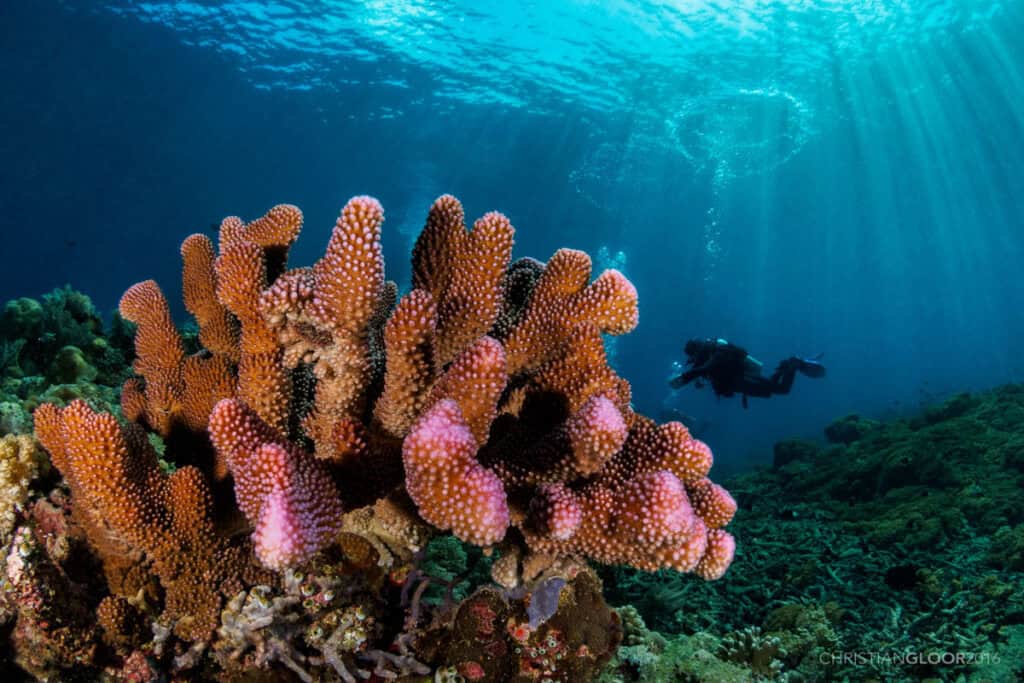
- Best time of year for diving: While diving is possible in Komodo year round, hands-down the best time to go is during the months of July – October when you are more likely to spot sharks, rays, dugongs, dolphins, and turtles.
- Average water temperature:
- July – September: 81 °F, or 27 °C
- November – May: 84 °F, or 29 °C
Komodo National Park is arguably one of the best and most (relatively) accessible diving areas in Indonesia. Here divers have the chance to see sharks, rays and dolphins in a variety of dive sites and conditions.
It is important to point out that the national park is known for having strong currents, which can make diving here a bit more challenging than in other destinations.
We chose Komodo National Park as the destination for our second Liveaboard trip and were more than pleased with the diving conditions and abundance of dream-like marine life.
Our top Liveaboard choice: Amalia Komodo
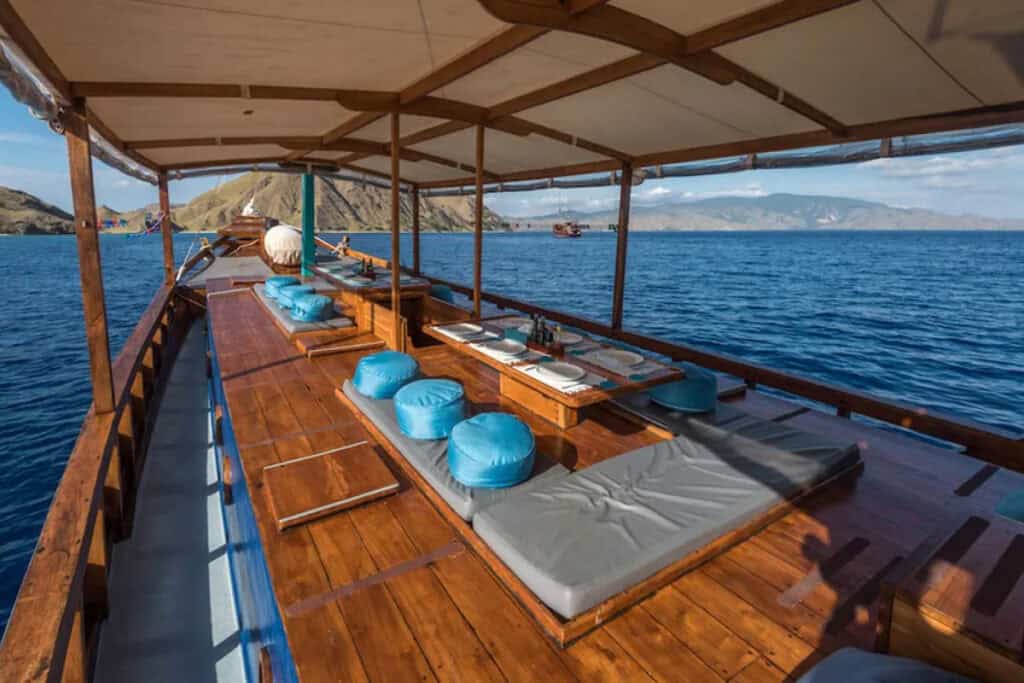
- Length of voyage: 4, 5 and 6 days
- Ship size: Up to 11 guests
- Cost: starting at $218 USD / day
This 29-meter (95-feet) phinisi-style Komodo Liveaboard offers seasonal diving itineraries in both North and South Komodo.
The boat features 5 naturally ventilated cabins: 2 en-suite double cabins, 2 twin bunk rooms, and 1 family cabin, with shared bathroom facilities for the twin and family cabins.
Itineraries onboard the Amalia Komodo include 11 dives (with a night dive!) and trekking adventures on land to see Komodo Dragons, Pink Beach, and the Padar Island hike. There are also opportunities for snorkeling, paddleboarding, and relaxing on the spacious sun deck.
We also have an entire article where we rounded up the best Liveaboards in Indonesia for every budget.
Great Barrier Reef (Coral Sea), Australia
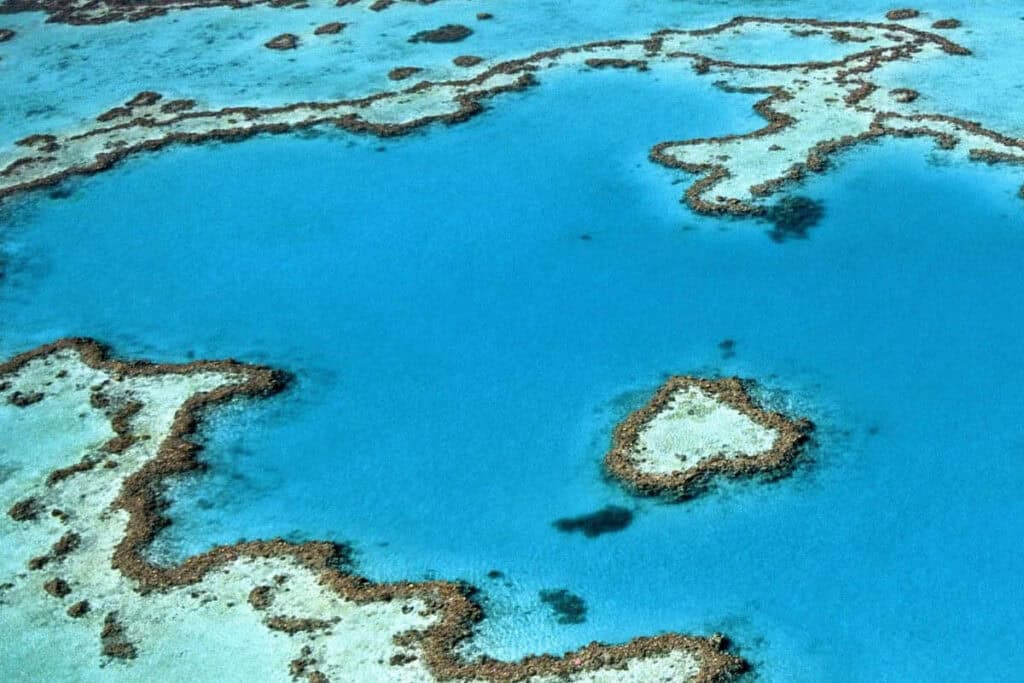
- Best time of year for diving: Diving in the Coral Sea is possible all year round, however the best conditions will be from August – December when they experience the least wind and rain.
- Average water temperature: Water temperatures vary in the Coral Sea by season, reaching an average of 66 °F / 19 °C during the winter months, and an average of 75 °F / 24 °C during the summertime.
Have you ever asked yourself what coral reefs would look like if humans didn’t exist? There aren’t many places left on this planet that can give you the experience of traveling back in time to a marine playground as virtually unspoiled by human interaction as the Coral Sea.
Located off the northeastern coast of Australia, the Coral Sea is a diver’s paradise known for its pristine reefs, dramatic drop-offs, and abundant marine life. With visibility often exceeding 30 meters, divers can enjoy stunning coral formations, large pelagic species, and often shark encounters.
Our top Liveaboard choice: Spoilsport Liveaboard
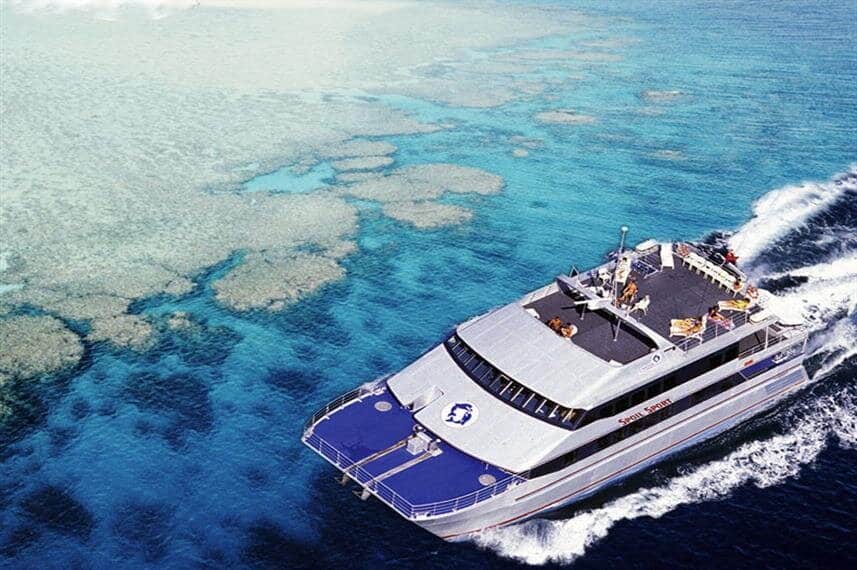
- Length of voyage: 4, 5, 6 and 8 days
- Ship size: 28 guests
- Cost: starting at $338 USD / day
The MV Spoilsport Liveaboard is an award winning ship that was custom built to explore the Coral Sea on the ultimate diving holiday. The multi-level catamaran has cabins to accommodate a range of budgets.
Guests can relax in the entertainment lounge, partially shaded sundeck and bar areas. Chef-prepared meals are served in the indoor salon and dining room. A specious dive deck allows for easy access and exit from the water.
Maldives
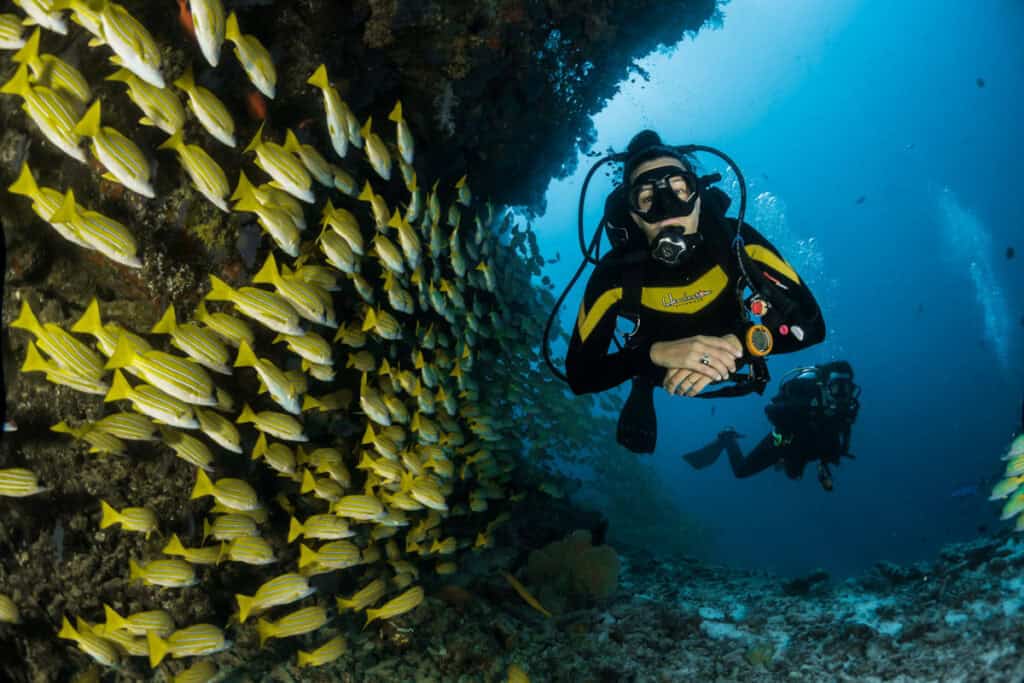
- Best time of year for diving: The diving is good in the Maldives all year round, however some prefer to avoid the rainy season, which is at its peak from June – August. The best time to see manta ray and whale sharks is from May – November.
- Average water temperature: The water temps in the Maldives are warm all year round, ranging from 82-86 °F / 28-30 °C
Some people think of the Maldives and see palm tree dotted white sand beaches with overwater bungalows jutting out into turquoise waters. Below the surface, the nutrient rich water with an abundance of marine life draws divers from around the world to explore the tropical waters of the Maldives.
Go diving in the pristine and mostly untouched waters where you can expect to see brightly colored reefs of soft and hard corals, overhangs, dolphins, sea turtles, manta rays and whale sharks.
You might even have a sighting of any number of rare sharks from the tiger shark to the gray reef shark and whitetips.
Our top Liveaboard choice: Felicity Liveaboard
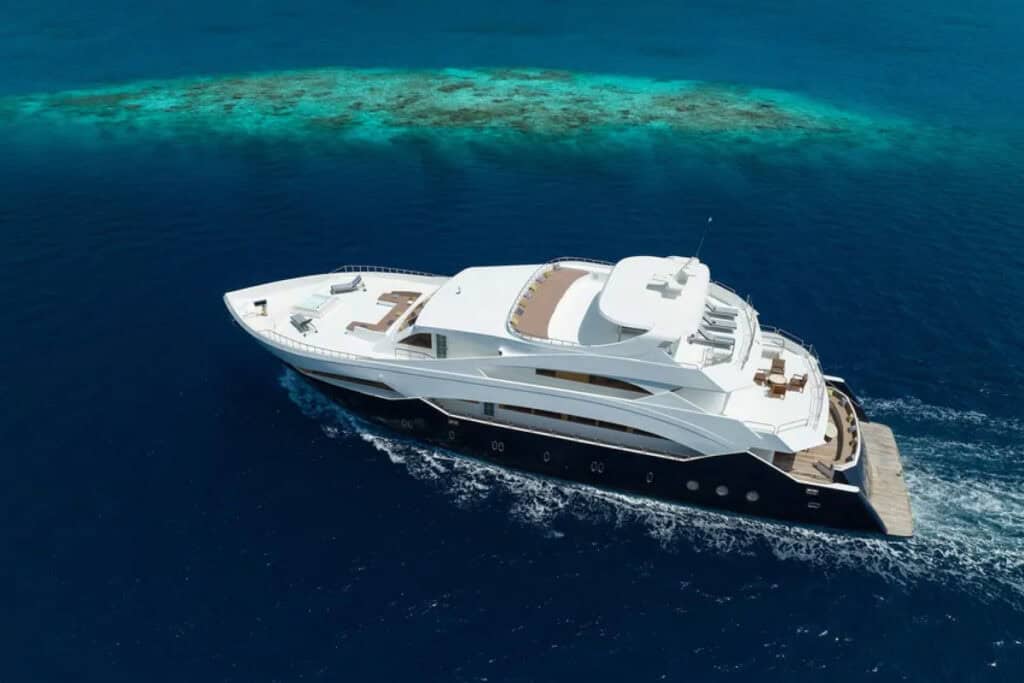
- Length of voyage: 8 days
- Ship size: 24 guests
- Cost: starting at $221 USD / day
The luxurious 41-meter (134-foot) Felicity Liveaboard offers fantastic trips around the most popular diving areas in the Maldives.
Each air-conditioned cabin offers modern amenities and an ensuite bathroom. Other features on this luxury yacht include an indoor lounge with entertainment system, a sundeck, shaded outdoor seating and dining areas and an onboard jacuzzi.
The Philippines
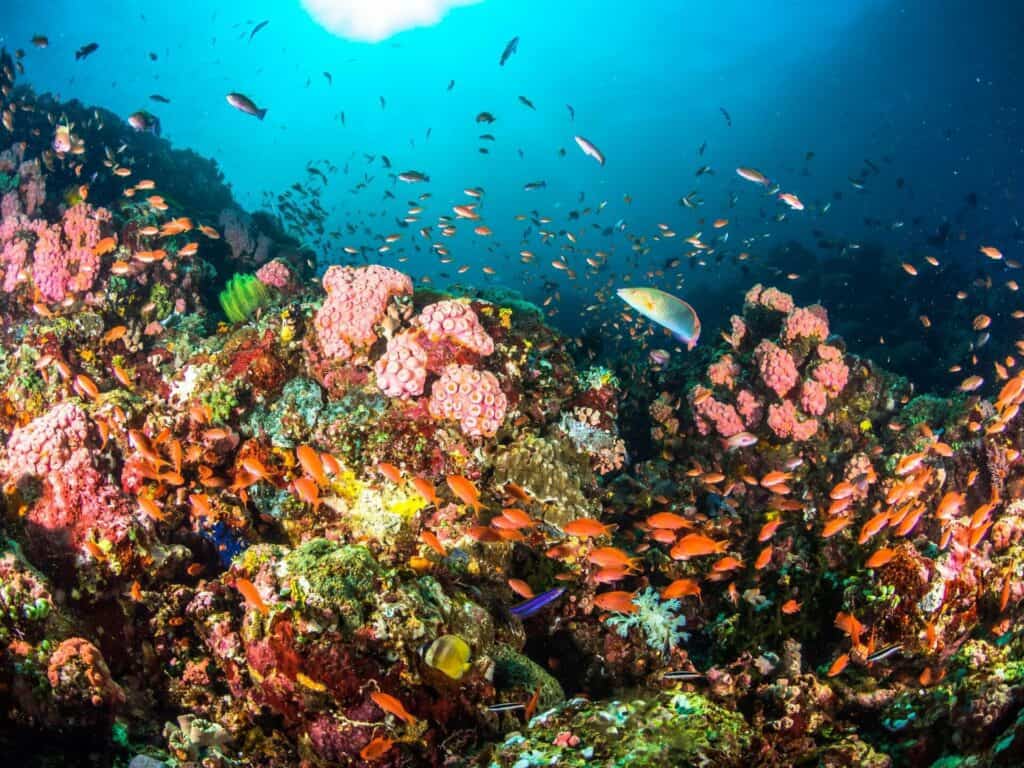
- Best time of year for diving: Diving is possible year round in the Philippines, however there are 3 distinct seasons that will affect conditions. Your best chance of spotting some of the most interesting macro species is in May, during peak tourist season, when it is also very dry.
- Average water temperature: Water temps in the Philippines stay around 78-82 °F / 26-28 °C year round, however, they can drop down to 75 °F / 24 °C during the winter months of January – March.
With over 7,000 islands, located in the Indo-Pacific’s coral triangle, it’s no wonder the Philippines is one of the best Liveaboard diving locations in the world. With pristine reefs and coral gardens, WWII shipwrecks and macro species such as whale sharks, there is something for every diver in the Philippines.
Psst! Itching to travel to the Philippines?! We’ve got you covered with everything you need to know about planning a trip to the Philippines.
Our top Liveaboard choice: Infiniti Liveaboard
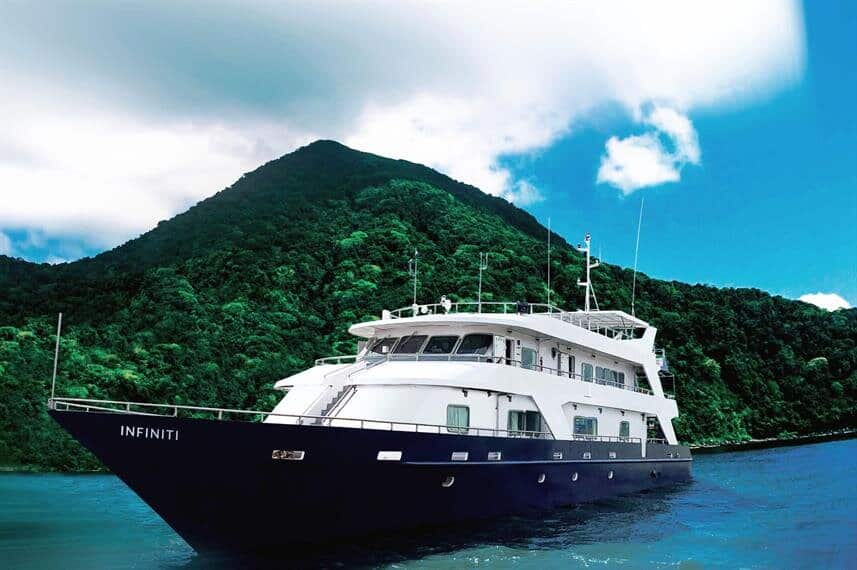
- Length of voyage: 7 days
- Ship size: 22 guests
- Cost: starting at $251 USD / day
With Infinity Liveaboard you will have the chance to dive at some of the best sites in the Philippines. The ship features climate controlled cabins with ensuite bathrooms, both indoor and outdoor lounges, and a massive sundeck with cushion loungers and hammocks.
The large dive deck, top of the line equipment, rinse tanks, camera tables, and charging stations, are just some of the diving amenities that you will enjoy onboard the Infiniti.
Belize
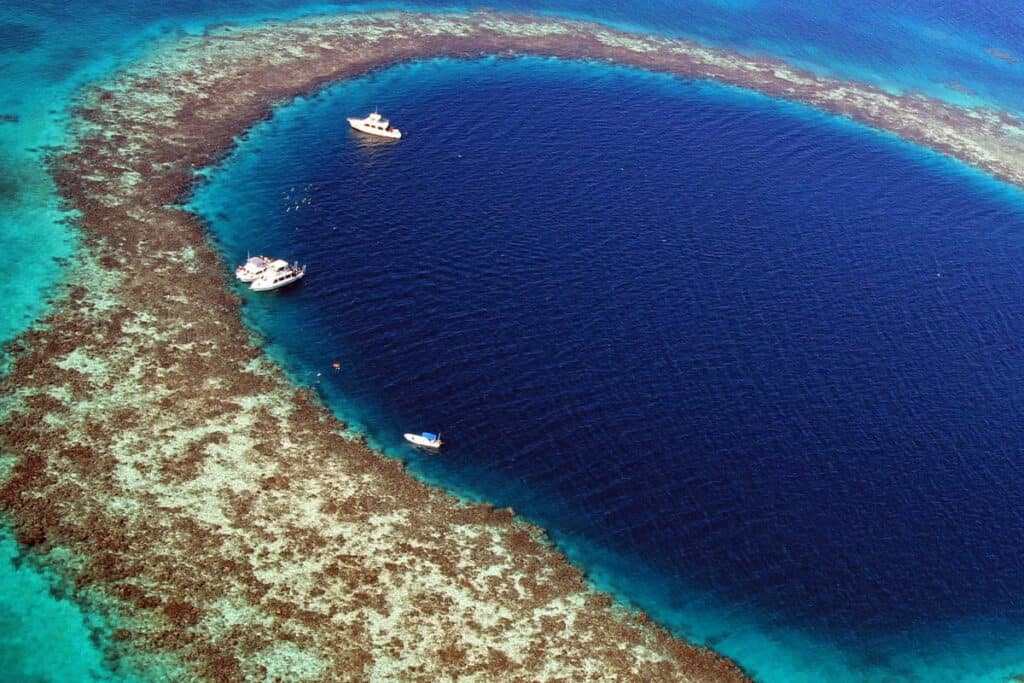
- Best time of year for diving: Diving can be done year-round in Belize, while March-December are considered the optimal time with the best conditions for marine life. October – November is grouper mating season when thousands of these fish descend upon the warm waters of Belize to mate and give birth.
- Average water temperature: Waters reach a warm 85 °F / 30 °C in the summertime and cool off to about 79 °F / 26 °C in the winter.
You’ve probably heard that Belize has some of the best diving in the world, and you may even recognize photos of the famous Blue Hole. But did you know that Belize is also home to the longest unbroken barrier reef in the western hemisphere!? Neither did we until we were doing research for this blog post!
Second only to the Great Barrier Reef in Australia, it’s home to more than 500 species of fish and 100 species of coral all throughout the reef system. In 1996, the Belize Barrier Reef was even named a UNESCO World Heritage Site.
Our top Liveaboard choice: Belize Aggressor III
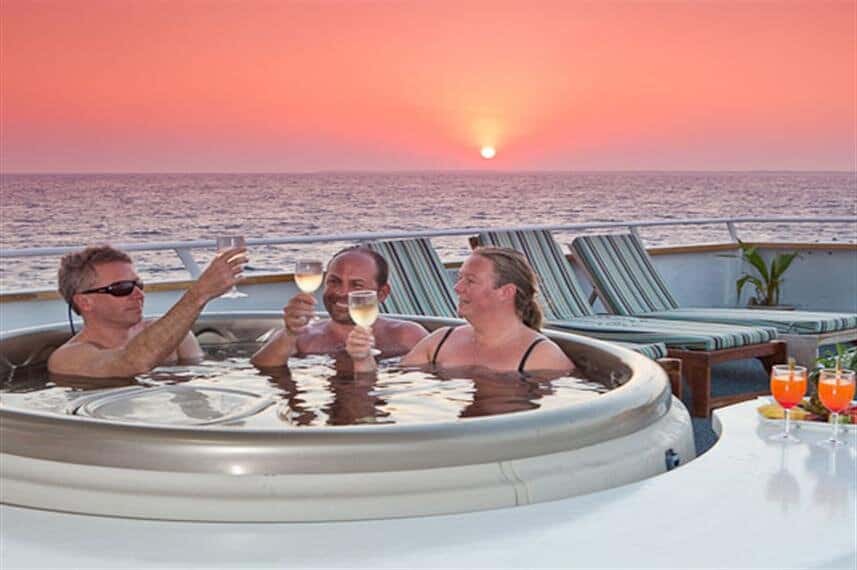
- Length of voyage: 8 days
- Ship size: 18 guests
- Cost: starting at $319 USD / day
Offering up to 5 dives per day, including the option for night dives, the Belize Aggressor III is a great choice for a Liveaboard in Belize.
The boat features climate controlled cabins with private ensuite bathrooms, an entertainment salon, sundeck with loungers and a hot tub. Diving facilities onboard include a dive deck with personal gear bins, rinse tanks, air/nitrox fills, and a three-tiered camera table with low-pressure air hoses, E-6 photo lab, and camera rinse tank.
Bay Islands, Honduras

- Best time of year for diving: Diving can be done year-round and whale sharks can be spotted for most of the year. Rainy season lasts from October to December, so if you’d prefer to avoid the rain, travel outside of these months.
- Average water temperature: The warm Caribbean waters average 78 °F / 25 °C in the winter and 84 °F / 29 °C in the summer.
While Honduras isn’t on the radar for many travelers, the Bay Islands make an excellent destination for scuba diving Liveaboards. Sitting just off the coast in warm Caribbean waters you’ll find world-class diving, white sand beaches, and island vibes without insane prices.
The waters around the Bay Islands are known for having excellent visibility (up to 45 meters / 150 feet!) and many divers come here for the chance to spot an elusive whale shark. (We did a few dives and just missed seeing one of these beauties!) But even if you’re not lucky (like us!) there’s still plenty to see beneath the water’s surface.
Interesting to know: In the Caribbean, lionfish are an invasive species. We’re used to seeing them a lot in Southeast Asia, but in Central America divers hunt the non-native lionfish in order to protect the environment. You might see divers with tubes and arrows for hunting and storing their pretty. Apparently they make great sashimi! Who knew?!
Of the Bay Islands, the two most well-known are Utila and Roatan. They each have very different vibes: Utila is a laidback backpacker retreat where cheap dive schools are aplenty and nightlife is wild. Roatan, on the other hand, is a much larger island where you can find more upscale accommodation (though you’ll find plenty on a budget too), and less of the backpacker/party crowd.
Psst! We’ve written a whole guide to Utila and Roatan to help you plan your trip there!
Our top Liveaboard choice: Roatan Aggressor
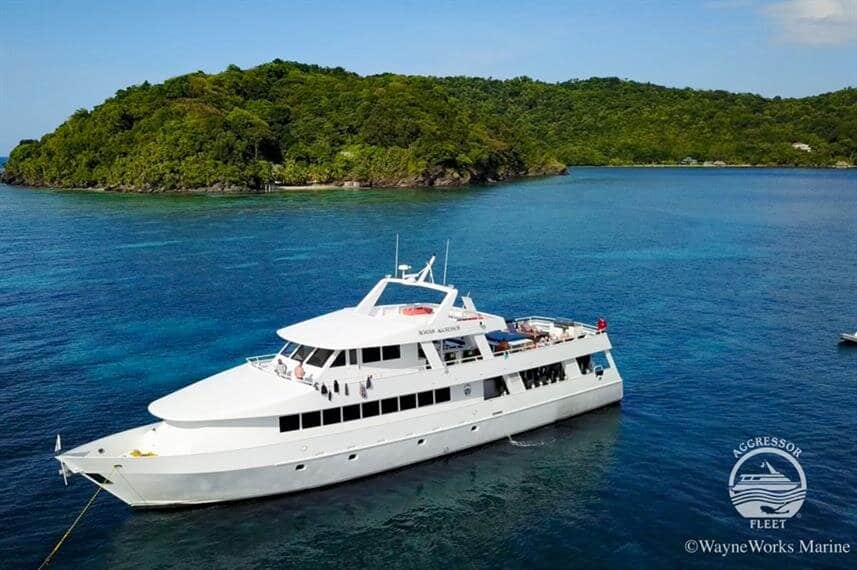
- Length of voyage: 8 days
- Ship size: 18 guests
- Cost: starting at $276 USD / day
The Roatan Aggressor is the only scuba diving Liveaboard (that we could find) that runs out of the Bay Islands. However, after seeing pictures and reading reviews, it looks like an excellent value for money! Plus you get the opportunity to do some unique dives, like a shark dive and one in which you hunt lionfish (see note above).
This Liveaboard accommodates up to 18 guests in 9 en suite cabins. Each of the cabins features individual climate control, a hairdryer, bathrobes, ample storage space, a TV monitor with a media player and movie selection, as well as a nightly turndown service and morning beverage service to ensure maximum comfort.
Social areas on the Roatan Aggressor include an indoor lounge with an entertainment system, a dining area, a wet bar, an outdoor covered seating area, and a spacious sun deck with a hot tub. Breakfast is cooked to order, lunch is served buffet style and dinner includes tableside service.
Tips for choosing the best scuba diving Liveaboard
With nearly 500 scuba diving Liveaboards available worldwide, it can be overwhelming trying to figure out which one to choose. Here are some tips we’ve picked up from our own experience on how to choose a Liveaboard experience that’s best for YOU.
1. Look beyond the daily rate
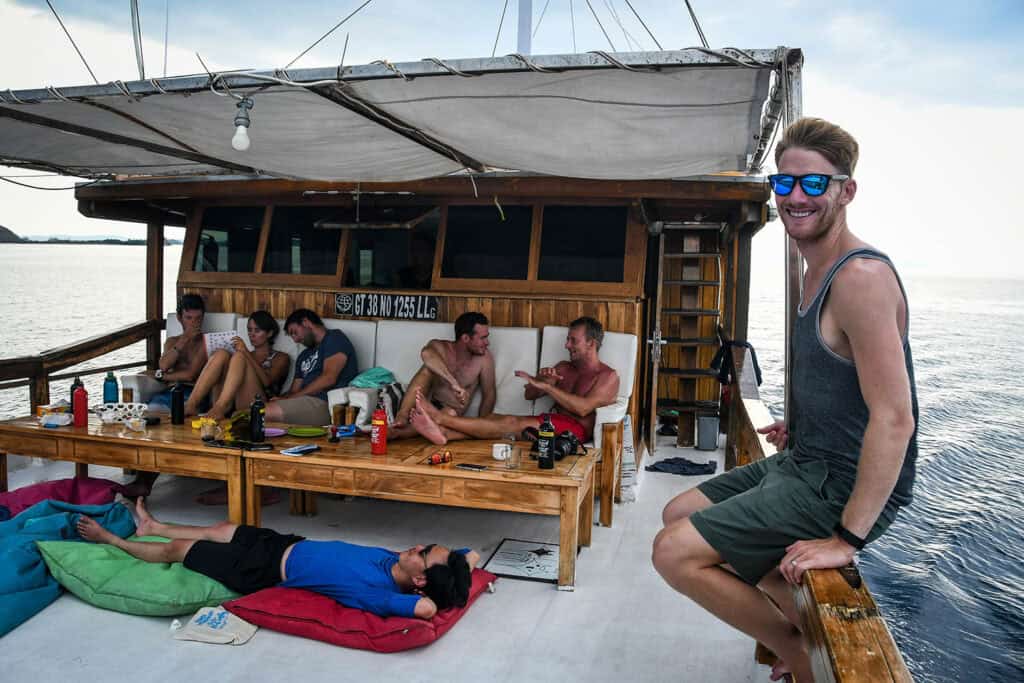
Not only pay attention to the daily rates we’ve listed in our list above, but look at how many days the itineraries are. You may find the cheaper daily rate only offers long 10+ day itineraries making your total go way up from the slightly more expensive Liveaboard with a short 4 day itinerary.
Ask about park fees, and if they are included in your rate, as well as alcoholic beverages and anything else that may be an additional cost.
It’s also a good idea to think about tipping when calculating your total Liveaboard budget. It doesn’t hurt to ask ahead of time how much is typical for guests to leave as gratuity.
2. Pay attention to the sleeping arrangements
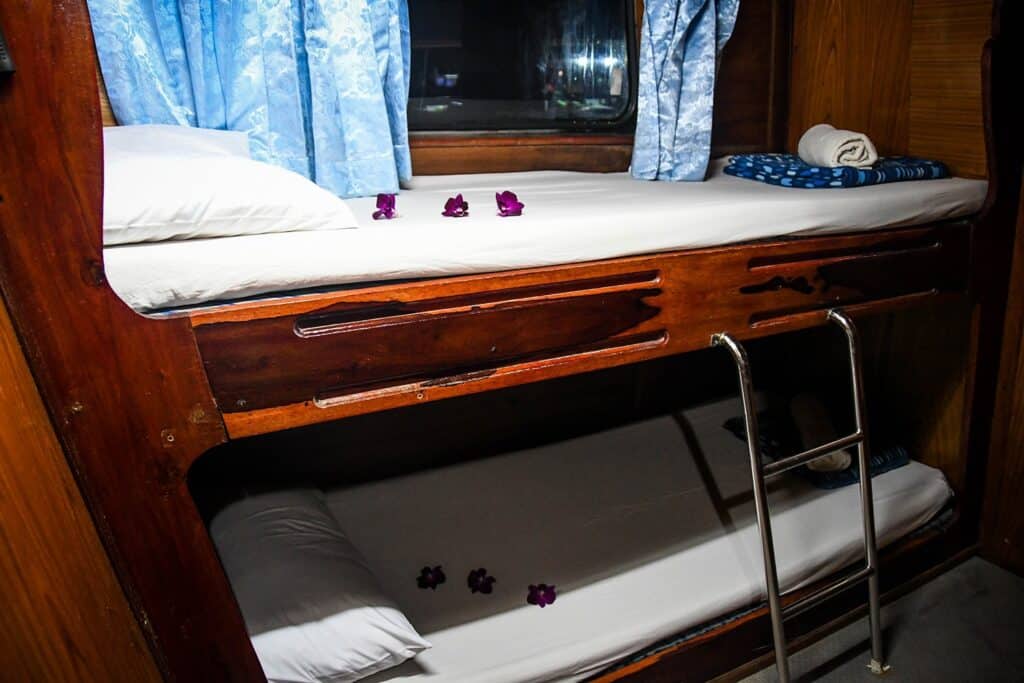
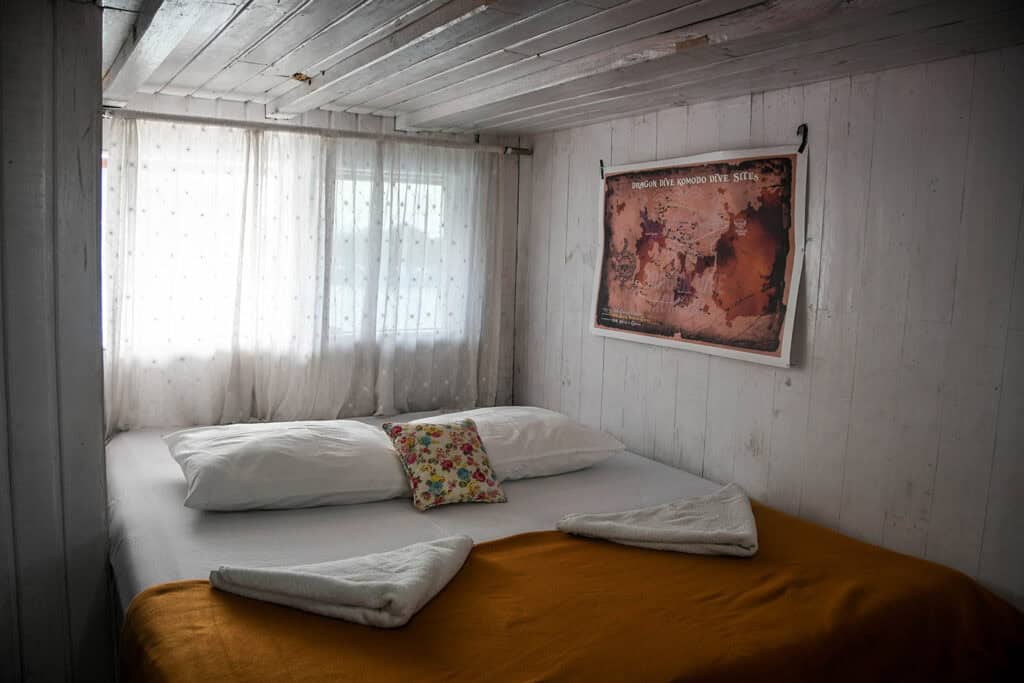
Are the cabins onboard shared or private? Double occupancy or single? We’ve seen a Liveaboard that doesn’t offer cabins at all—the whole group sleeps on the top deck under the stars each night.
While that may be great if you’re trying to minimize your budget, it’s a good thing to know before you book.
Also check to see if your cabin offers air conditioning and if it’s individually controlled or not. If a Liveaboard says it has “naturally ventilated” cabins, that’s a nice way of saying they do not have AC.
3. Find out the bathroom situation
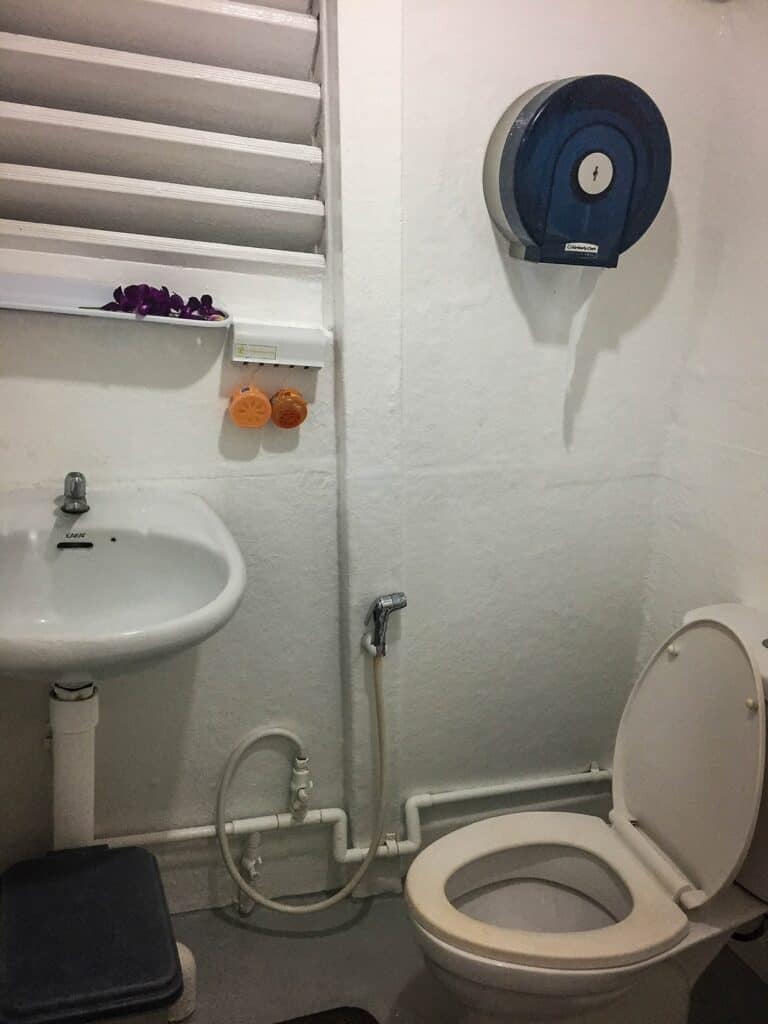
Are the bathrooms on board private ensuites in each cabin, or will you be sharing a bathroom with other guests?
If you’re going for a shared bathroom situation, check how many guest bathrooms there will be compared to the number of guests onboard to get an idea of what that situation will be like.
4. What kind of food is served onboard
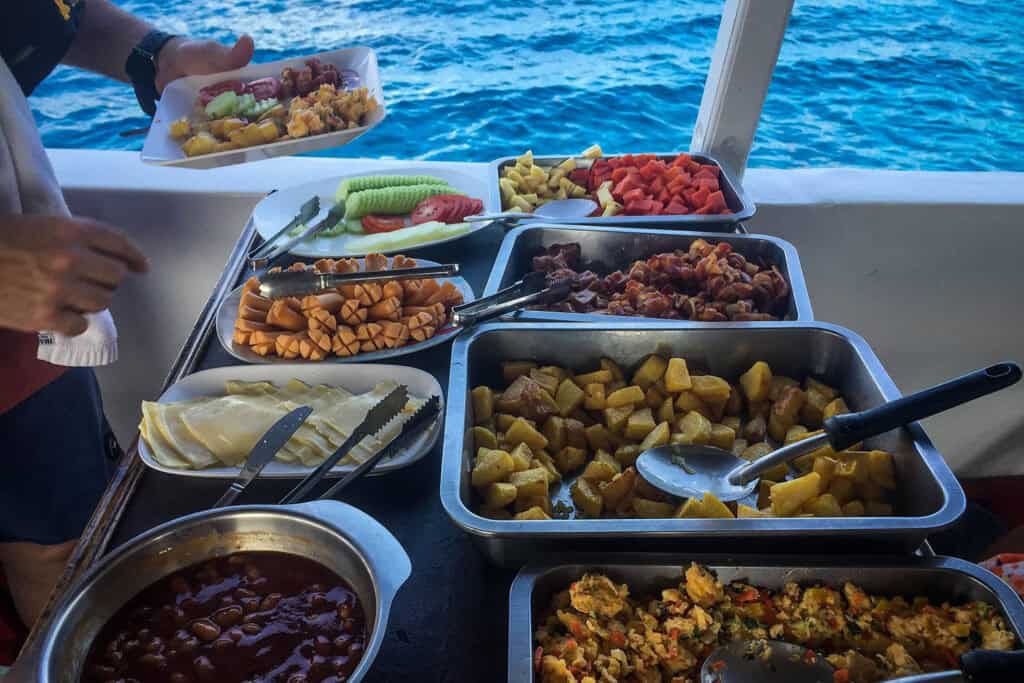
Some of the scuba diving Liveaboards describe having both local and Western cuisine options, but some only offer the local cuisine.
If you have any special dietary needs or restrictions, it’s a good idea to ask beforehand if they will be able to accommodate you.
5. Ask about the diving onboard
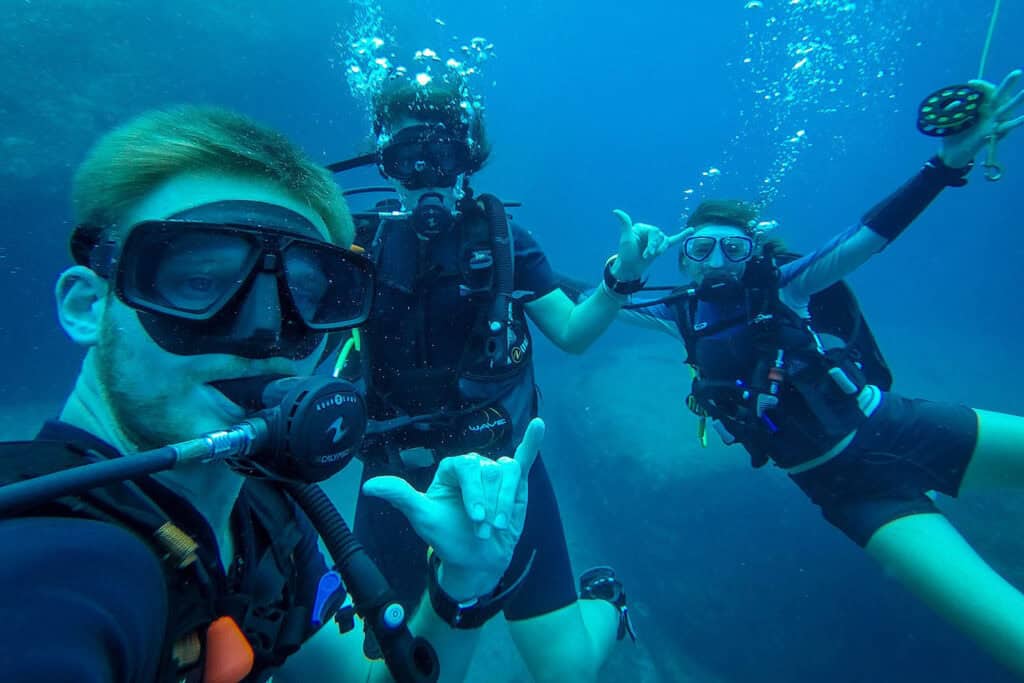
Find out how many dives are offered each day, and if there are any special dives like night dives available. It’s also good to find out if there are any diving experience requirements for participating (some boats have minimum dives or advanced certification requirements).
You should also ask about the diving equipment onboard—how old it is, if it’s well-maintained and if it’s all included in the cost of the Liveaboard or if there are extra rental costs for things like dive computers.
If you are an underwater photography enthusiast, it’s good to know that some Liveaboards include space for underwater photography and equipment rentals.
6. Find out if there are any on-land excursions
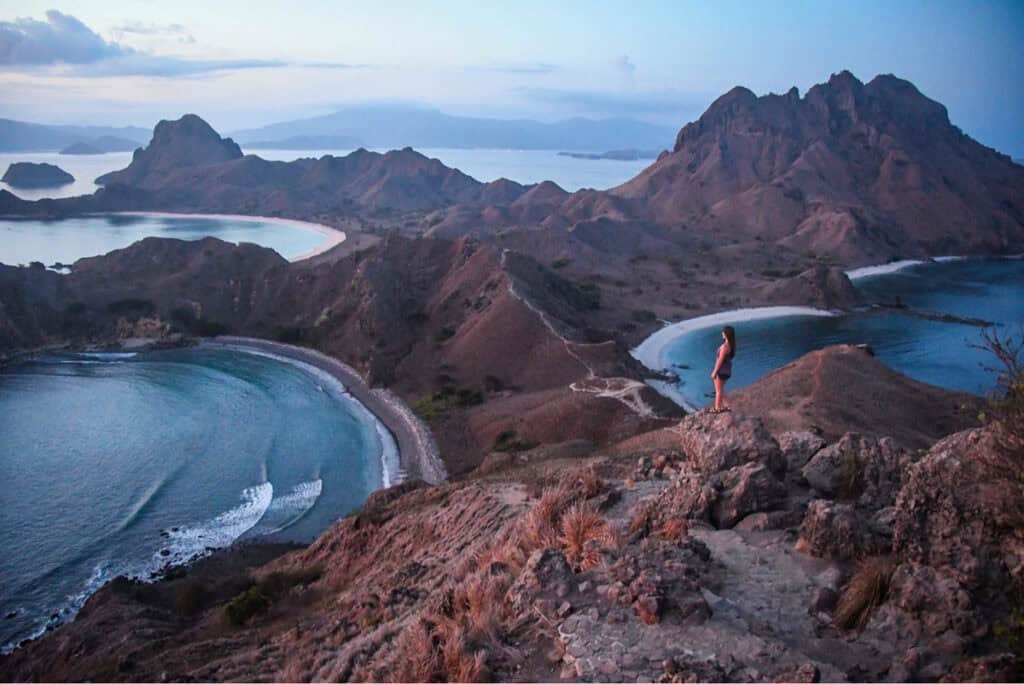
One of the perks of our Komodo Liveaboard was getting to experience some of the unique features of Komodo National Park on land. We got to do some hiking and see the famous Komodo dragons in person.
Having onland excursions isn’t always common depending on where you do your scuba diving Liveaboard, but can be a nice way to break up the monotony of being at sea everyday, and give your sea legs a nice break too!
What to pack for a Liveaboard diving trip
Figuring out what to pack for a scuba Liveaboard can be tricky… you want to be prepared, but you definitely don’t want to overpack when you’re going to be living in tight quarters. There are some definite musts that you don’t want to forget, and even more things that you should just leave on land.
We’ve taken all the guesswork out of packing for you and compiled a complete liveaboard packing list so you don’t forget any essentials on shore. Oh, and it’s totally FREE!

Don’t forget about travel insurance!
World Nomads provides coverage for adventure activities like scuba diving that aren’t usually covered (read the fine print!) in typical travel insurance policies. We recommend getting their short-term trip coverage (on top of your regular travel insurance plan) if you plan on doing a Liveaboard diving trip.
Get an instant quote on World Nomads right now, it’s that simple! It’ll take less than 3 minutes.
Are you interested in Liveaboard diving and want help planning your trip?
We have some great resources for you!

Planning a Liveaboard Diving Trip
From the diving equipment to the bathroom situation, here’s everything you need to know about planning a Liveaboard diving trip. We’ll walk you through a typical daily schedule and clue you in on what to expect for the onboard experience. Plus we’ll include some expert tips and insider advice we wish we would have known before our first Liveaboard.
Before you go…
- Read our personal account of our Similan Islands Liveaboard, our first ever Liveaboard dive trip!
- We gathered up all the best Thailand Liveaboards for every budget.
- Find out why our Komodo Liveaboard was the ultimate diving experience in Indonesia.
- Check out our roundup of the best Liveaboards in Indonesia, and if you already know you want it, here are the best Liveaboards in Raja Ampat.
- If you’re staying in the western hemisphere, these Galapagos Liveaboards are some of the best in the world!
Save this article on Pinterest for later!
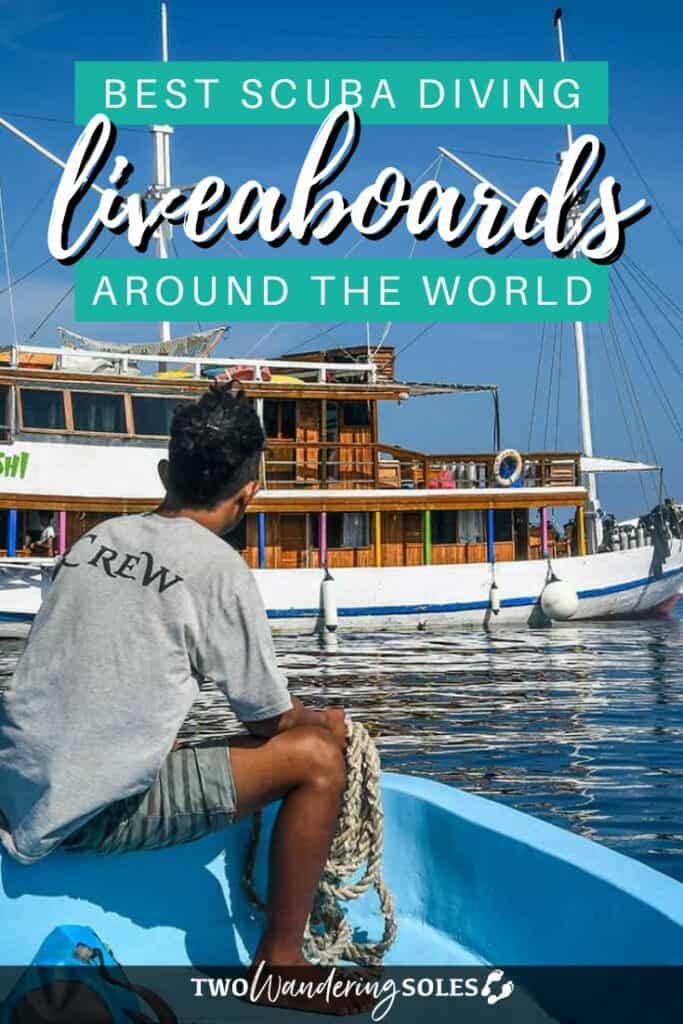
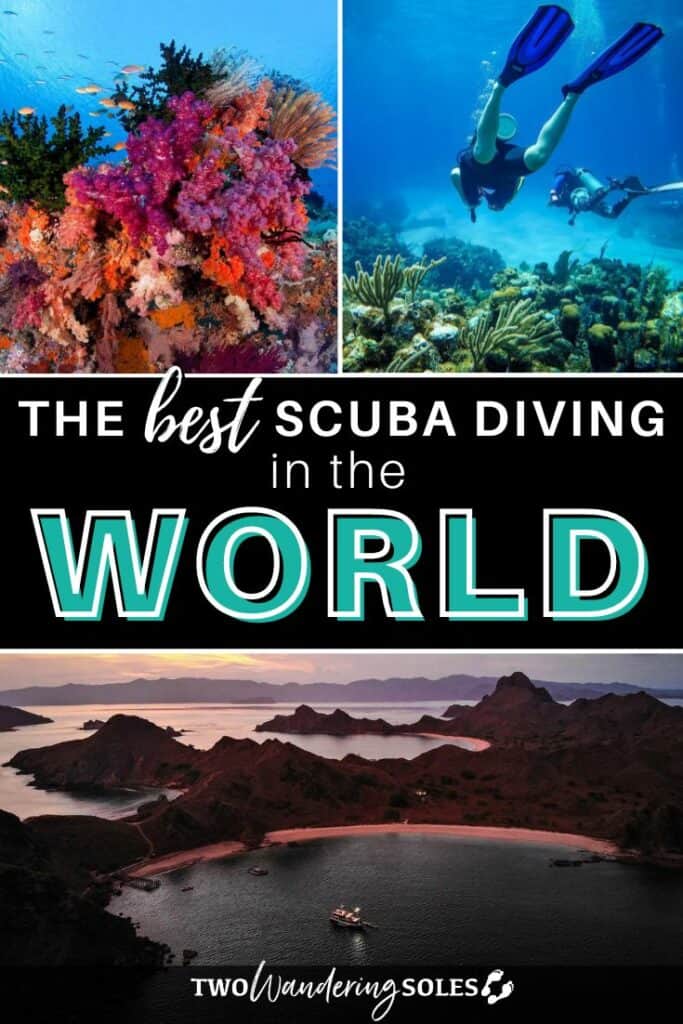
We want to hear from you!
Which of these scuba diving Liveaboards would you choose? Have you been diving in one of these locations before? What was your experience like? Comment below and we’ll do our best to get back to you!

Komodo Island is my favourite site so far but I still have many places to visit out of that list
I love this guide. I have explored a few of the sites you mention but I still have many on my list. Great inspiration.
Komodo Island is my favourite site so far but I still have many places to visit out of that list!!!! Also really enjoyed the cenotes in Mexico
This is such a great guide! I would love to go diving in Bora Bora!
Us too! It looks amazing!
I’m kind of scared of diving, but those liveaboard boats look amazing, would love to be in that hot tub!
Definitely one of our travel goals: liveaboard with a hot tub!
Ah, memories of diving! I’ve dived at a couple of those and it would be lovely to see the others. There is definitely nothing like diving.
Every time I dive, I feel like I entered another world! Such an amazing feeling!
Wow those are some of the great locations.my goal for this year was scuba diving.hope to make it
Scuba Diving around the world has quickly become one of our favorite hobbies! Let us know where you go diving!